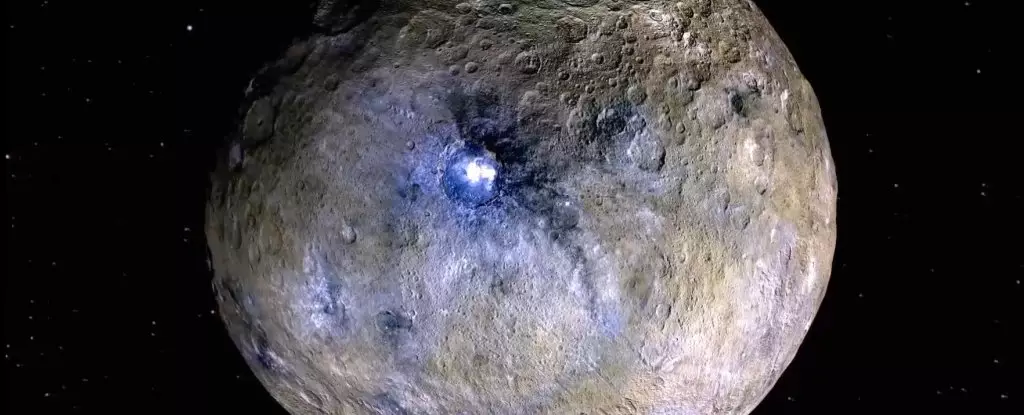Ceres, the solitary dwarf planet nestled in the asteroid belt between Mars and Jupiter, has long been of interest to astronomers and planetary scientists alike. Since its discovery in 1801, Ceres has captivated the attention of researchers seeking to understand the origins and composition of our Solar System. While often classified as an asteroid due to its locational context, its spherical shape and size—approximately half that of Pluto—demand a more nuanced classification. Ceres stands out not only as the largest object in the asteroid belt but also as a unique entity that offers a treasure trove of information about the potential for ice-covered oceans beyond Earth.
Recent studies suggest that Ceres might possess a crust comprising over 90 percent water ice—a revelation that could drastically reshape our understanding of this dwarf planet. Historically, estimates regarding the water content in Ceres were conservative, predicated upon surface cratering patterns that indicated a much lower ice content, roughly 30 percent. Researchers assumed that if significant amounts of water ice existed, it would be subject to gradual deformation, leading to smoother and shallower craters. This assumption, however, faced scrutiny following data collected by NASA’s Dawn spacecraft, which revealed a more rugged surface than was expected.
Planetary geophysicist Mike Sori from Purdue University and his team undertook extensive simulations to elucidate how ice might retain its structural integrity even with significant impurities mixed in. Their work demonstrates that ice could exhibit unexpected strength in Ceres’ conditions, suggesting that the presence of solid rock mixed with water ice could inhibit the typical flow associated with glacial movement. This insight allows for a reconsideration of how craters on Ceres are formed and maintained, proposing a model where a high concentration of ice exists near the surface, diminishing with depth.
The Role of Impurities in Crustal Stability
The findings from Ian Pamerleau and his team underline the importance of structural integrity provided by non-ice impurities—essentially how a little dirt can go a long way. Ice, subject to extreme pressure over geological timescales, does flow; yet when mixed with solid particles, its behavior changes dramatically. The simulations indicated that even with a predominantly ice-rich crust, Ceres could display minimal crater relaxation over time. Such revelations are pivotal for understanding not just Ceres itself but the broader category of icy bodies within the Solar System.
As researchers explore further, they draw significant parallels between Ceres and other celestial bodies believed to harbor subsurface oceans, such as Jupiter’s moon Europa and Saturn’s moon Enceladus. Both moons exhibit thick icy shells, under which a liquid ocean is thought to exist, maintained by tidal heating—a phenomenon absent on Ceres due to its solitary orbital path. This distinction raises intriguing questions about what lies beneath Ceres’ surface and how its past oceanic experience may have shaped its current icy crust.
The implications of these findings extend beyond Ceres; they suggest that many ocean worlds might possess unexpected characteristics. Sori proposes that Ceres may once have harbored a dynamic, muddy ocean that has since frozen over, leaving behind a unique surface. This transformation positions Ceres as a fascinating analog for other icy moons in the Solar System, offering scientists a chance to better understand the diversity of ocean worlds.
With Ceres being one of the most accessible icy bodies to study in our neighborhood, it stands at the forefront of planetary exploration. The potential for future missions to this dwarf planet looms large, as Ceres could serve as a pivotal comparative study for analyzing the ocean-hosting icy moons in outer space. The possibility of sending additional spacecraft could yield new data, enhancing our understanding of planetary formation, oceanic chemistry, and the potential for extraterrestrial life.
The new theories surrounding the icy composition of Ceres usher in an exciting era of research within planetary science. As we continue to unveil the mysteries of this intriguing dwarf planet, it serves as an important reminder of the complexities of celestial bodies within our Solar System. Understanding Ceres offers critical insights into the nature of ice-covered worlds and challenges preconceived notions about their features and compositions. As interest grows, Ceres remains a prime candidate for further exploration, promising to deepen our comprehension not just of itself, but of the intricacies of ice-rich spirits roaming the cosmic seas.


Leave a Reply